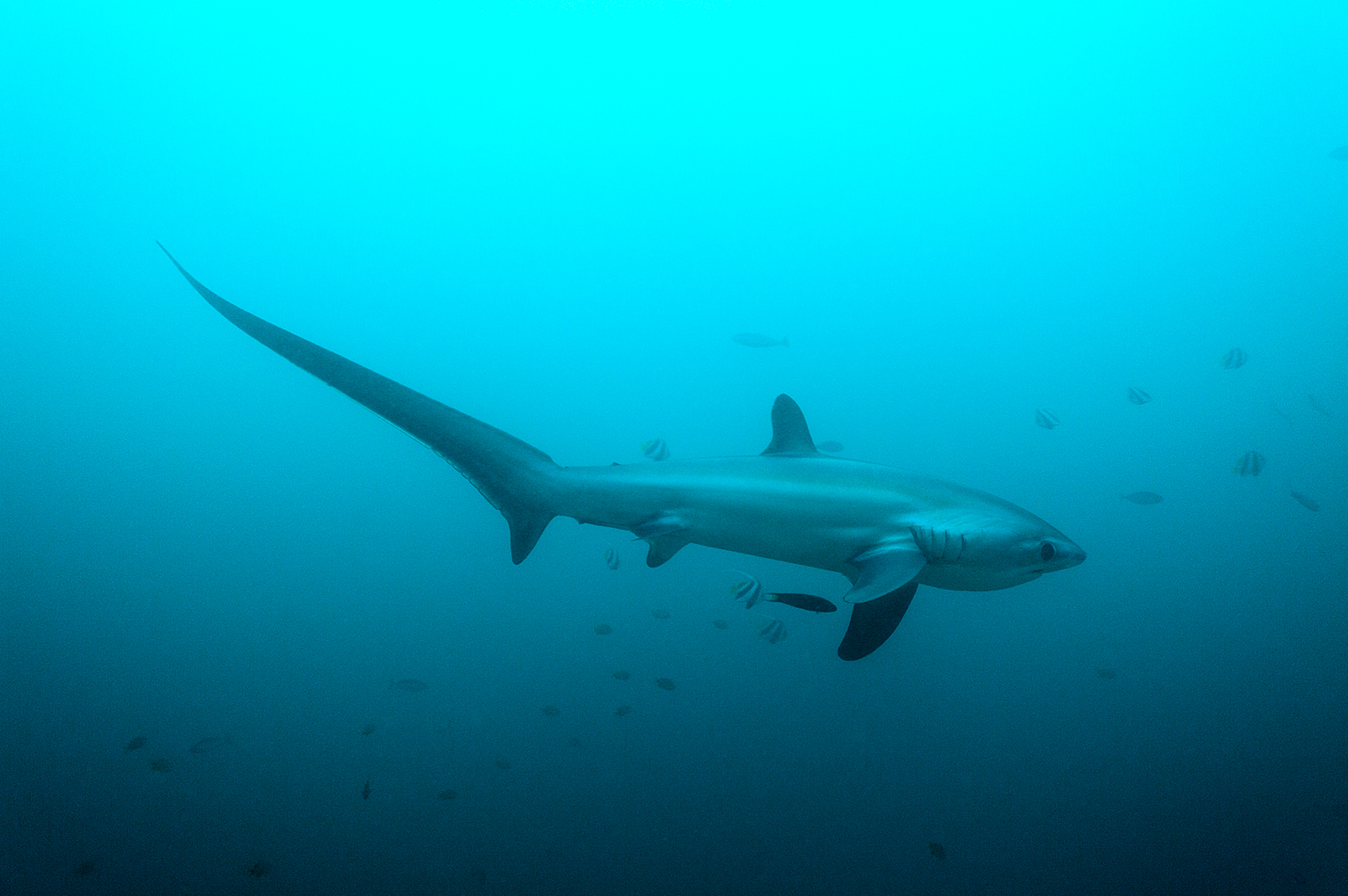- Classification
- CHONDRICHTHYES
- LAMNIFORMES
- ALOPIIDAE
- Alopias
- pelagicus
Pelagic Thresher, Alopias pelagicus Nakamura 1935

A Pelagic Thresher Shark, Alopias pelagicus, at A Pelagic Thresher Shark, Alopias pelagicus, at Monad Shoal, Malapascua, Philippines, September 2014. Source: Klaus Stiefel / Flickr. License: CC By Attribution-NonCommercial
A strong-swimming active shark with an enormous tail and large eyes.
Identifying features:
Upper caudal-fin lobe enormous, longer than rest of body;
Eyes large, positioned on side of head;
Middle of first dorsal-fin base closer to free tips of pectoral fins than to pelvic fins;
Pectoral fins almost straight with broadly-rounded tips;
Pale greyish above, underside whitish.
Thresher sharks use their enormous tails to feed on pelagic schooling fishes ans squids, by whipping the school to stun their prey.
Video of a Pelagic Thresher at Malapascua Island in the Philippines
Pelagic Thresher, Alopias pelagicus Nakamura 1935
More Info
|
Distribution |
Off the North West Shelf and off North West Cape, Western Australa. Elsewhere the species occurs in the tropical, Indo-Pacific. |
|
Size |
The smallest of the three recognised species of thresher shark, reaching 3.65 m TL. |
|
Biology |
Pelagic Threshers are late to mature and have low fecundity. |
|
Conservation |
|
|
Etymology |
The specific name is from the Greek pelágios (= of the sea), in reference to the fact that the species lives “in the upper layer of the sea.” |
|
Species Citation |
Alopias pelagicus Nakamura 1935, Memoirs of the Faculty of Science and Agriculture, Taihoku Imperial University 14(1): 2, pl. 1(2). Type locality: off Taiwan (as Formosa). |
|
Author |
Bray, D.J. 2023 |
|
Resources |
Pelagic Thresher, Alopias pelagicus Nakamura 1935
References
Cardeñosa, D., Hyde, J. & Caballero, S. 2014. Genetic diversity and population structure of the Pelagic Thresher Shark (Alopias pelagicus) in the Pacific Ocean: evidence for two evolutionarily significant units. PLoS ONE 9(10): e110193. https://doi.org/10.1371/journal.pone.0110193
Compagno, L.J.V. 1984. FAO Species Catalogue. Sharks of the World. An annotated and illustrated catalogue of shark species known to date. Hexanchiformes to Lamniformes. FAO Fisheries Synopsis No. 125. Rome : FAO Vol. 4(1) pp. 1-249.
Compagno, L.J.V. 2001. Sharks of the World. An annotated and illustrated catalogue of shark species known to date. Bullhead, mackerel and carpet sharks (Heterodontiformes, Lamniformes and Orectolobiformes). Rome : FAO, FAO Species Catalogue for Fisheries Purposes No. 1 Vol. 2 269 pp.
Compagno, L.J.V., Dando, M. & Fowler, S. 2005. A Field Guide to the Sharks of the World. London : Collins 368 pp.
Gilmore, R.G. 1993. Reproductive biology of lamnoid sharks. Environmental Biology of Fishes 38: 95-114.
Last, P.R. & Stevens, J.D. 2009. Sharks and Rays of Australia. Collingwood : CSIRO Publishing Australia 2, 550 pp.
Liu, K.-M., Changa, Y.-T., Ni, I.-H. & Jin, C.-B. 2006. Spawning per recruit analysis of the pelagic thresher shark, Alopias pelagicus, in the eastern Taiwan waters. Fisheries Research 82: 52-64.
Liu, K.M., Chen, C.-T., Liao, T.-H. and Joung, S.-J. 1999. Age, growth, and reproduction of the pelagic thresher shark, Alopias pelagicus in the Northwestern Pacific. Copeia 1999(1): 68-74. https://doi.org/10.2307/1447386
Macbeth, W.G., Vandenberg, M. & Graham, K.J. 2008. Identifying Sharks and Rays; a Guide for Commercial Fishers. Sydney : New South Wales Department of Primary Industry 71 pp.
Nakamura, H. 1935. On the two species of the thresher shark from Formosan waters. Memoirs of the Faculty of Science and Agriculture, Taihoku Imperial University 14(1): 1-6 figs 1-3.
Oliver, S.P., Turner, J.R., Gann, K, Silvosa, M, D'Urban Jackson T (2013) Thresher Sharks Use Tail-Slaps as a Hunting Strategy. PLoS ONE 8(7): e67380. https:doi.org/10.1371/journal.pone.0067380
Otake, T. & Mizue, K. 1981. Direct evidence for oophagy in thresher shark, Alopias pelagicus. Japanese Journal of Ichthyology 28(2): 171-172.
Patterson, J.C., Sepulveda, C.A. & Bernal, D. 2011. The vascular morphology and in vivo muscle temperatures of thresher sharks (Alopiidae). Journal of Morphology 272(11): 1353-1364.
Pepperell, J. 2010. Fishes of the Open Ocean a Natural History & Illustrated Guide. Sydney : University of New South Wales Press Ltd 266 pp.
Randall, J.E., Allen, G.R. & Steene, R. 1990. Fishes of the Great Barrier Reef and Coral Sea. Bathurst : Crawford House Press 507 pp. figs
Rigby, C.L., Barreto, R., Carlson, J., Fernando, D., Fordham, S., Francis, M.P., Herman, K., Jabado, R.W., Liu, K.M., Marshall, A., Pacoureau, N., Romanov, E., Sherley, R.B. & Winker, H. 2019. Alopias pelagicus. The IUCN Red List of Threatened Species 2019: e.T161597A68607857. https://dx.doi.org/10.2305/IUCN.UK.2019-3.RLTS.T161597A68607857.en. Accessed on 19 July 2023.
Sepulveda, C.A., Wegner, N.C., Bernal, D. & Graham, J.B. 2005. The red muscle morphology of the thresher sharks (family Alopiidae). Journal of Experimental Biology 208: 4255-4261 https://doi.org/10.1242/jeb.01898




